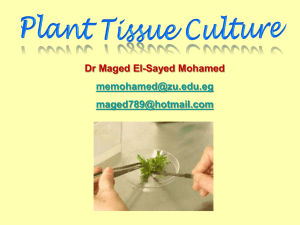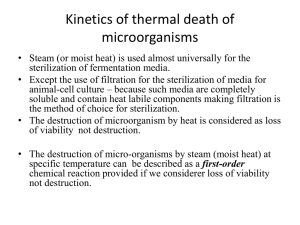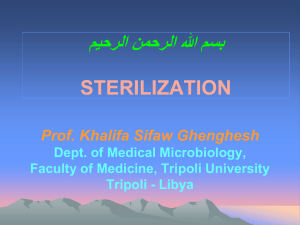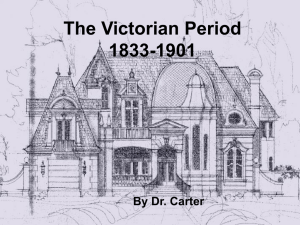What is contaminated
advertisement
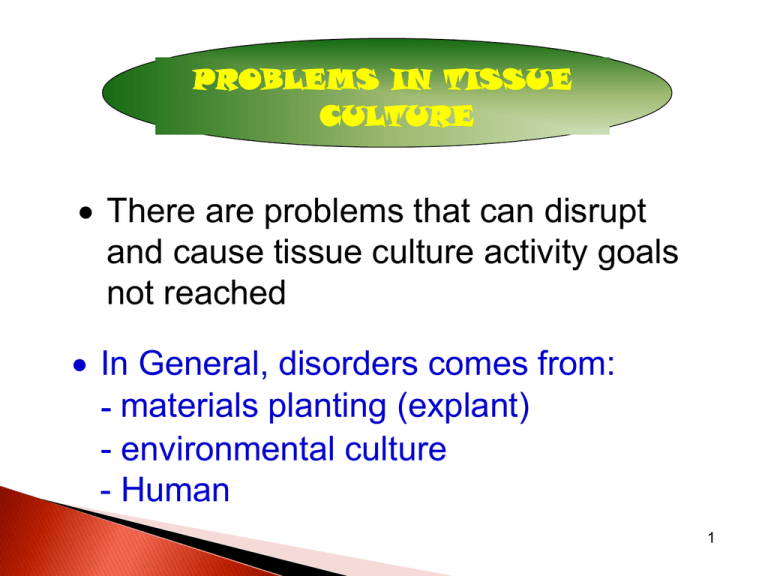
PROBLEMS IN TISSUE CULTURE There are problems that can disrupt and cause tissue culture activity goals not reached In General, disorders comes from: - materials planting (explant) - environmental culture - Human 1 • Problems relating to the material planting usually appears at the beginning of the growth phase : ˜ The quality of material planting/ explant is low (less well) ˜ The stagnation of growth ˜ Uncontrolled growth ˜ Contamination ˜ Browning ˜ Vitrification ˜ Genetic variability (can be viewed also as potential 2 Problems related to environmental factors: - The demise of the flow of electricity - Damage of Air Conditioner - Contamination Problems related to human beings: - Carelessness - Negligence - Low level of skills 3 CONTAMINATION Sterile condition is essential for success in the tissue culture procedures The aseptic condition are necessary to bottle culture, media, and planting equipment and explant Sterilization is one of the procedures used for eliminating microorganisms or efforts for freeing environmental from contamination by microorganisms 4 Contamination occurs as a consequence of use of the media –enriched the enriched a media, then the level of contamination is also increasingly and simple media components, the possibility of contamination is getting low VW Kudson MS 5 • Contamination is very diverse, as seen from: - Types of contaminants (bacteria, fungi, etc.) - Time of occurrence (fast can emerge within hours; medium can emerge within days; slow can emerge within month) - What is contaminated (media or explant) Need specific methode to each contamination 6 Based on differences in objects, sterilization can be classified in three categories, namely: 1. Sterilization of work environment. 2. Sterilisation of tools and media. 3. Sterilization of plant material (explant) The kinds of sterilization forms are distinguished: a. Sterilization with the heating (dry and wet) b. Sterilization with ultrafiltrasi c. Sterilization with chemicals Sterilization with moist heating: - Use steam heated autoclave - Almost all microbes die at temperatures of 120 0C - Time depend on volume Sterilization with dry heating: - Using the oven the tools are not flammable (material glass) long time warming up ± 45 minutes, the temperature of 160 0C) • Sterilization using flame: - Tools dipped in alcohol, then burned - Used for inoculation activities, planting of explant, etc. Sterilization with chemicals: - Used to sterilize the surface eg: explant, instruments, hand, room, or LAF - Chemicals that are commonly used alcohol, calcium hypochlorida, sodium hypochlorida, sublimat and chlorox • Sterilization using light: - Used on space/room and LAF - Using ultra violet rays Sterilization of Media and Tools Glass tools, equipment of metal or other materials not easily damaged by high temperature generally, sterilization with dry heating or wet warming Dissecting set and glass ware autoclave 121 0C about 20 – 30 minutes, then save in the oven at a temperature of 106 0 C for a few minutes Dissecting set dipped in alcohol 96% then burned before use 10 The kinds of Autoclave Media sterilization should not be too long because it can cause: a. The decomposition of sugar. b. The degradation of vitamins and amino acids c. Inactivation of sitocinin (zeatin riboside) d. Change in pH cause depolymerization of compactor . • The suggestion of a minimum time for media sterilization Media Volume (ml) Long time (121 0C) 20 – 50 15 minutes 75 20 minutes 250 – 500 25 minutes 1000 30 minutes 1500 35 minutes 2000 40 minutes 12 Sterilization of Culture Equipment 1. Clean bottles given some drops of aquadest and cover with paper or aluminum foil . To have the bottles lids autoclaveable, don't close it too tight, because during the heating expansion occurs. 2. Tools need to be sterilized before planting are: scissors, tweezers, scalpel handles, filter paper, petridish, empty bottles, and needles. 3. Alat-alat dan kertas saring dibungkus rapi dengan kertas tebal atau ditaruh dalam baki stainless steel dan bakinya dibungkus dengan kain tebal sebelum dimasukkan dalam autoklaf. Alumunium foil tidak direkomendasikan sebagai pembungkus, karena uap tidak dapat masuk ke dalam bungkusan. Alat-alat sektio seperti pinset, gunting, gagang skalpel, dan jarum, dibungkus dengan kertas kopi atau kertas merang. Hindarkan penggunaan Al-foil karena uap sukar masuk kedalam bungkusan sehingga sterilisasi kurang efektif. 4. Petri-dish akan disterilkan, juga dibungkus dengan kertas kopi atau kertas merang. 3. Tools and filter paper wrapped with a thick paper or put tray in stainless steel and the rest were wrapped with a thick cloth before you put in an autoclave. Tools such as tweezers, scissors, and a needle, scalpel, wrapped in paper copies. Avoid using of Al-foil because steam is difficult to enter the parcel, that the sterilization less effective. 4. Petri-dish would be sterilized, also wrapped in paper copies or paper volvacea. 5. Temperature used for empty bottle sterilization and the tools that will be used to explant planting is 121oC at 15 psi pressure (pounds per square inch) or 1 atm for 30-60 minutes. Sterilization time calculation begins after the desired pressure and temperature has been reached. Sterilization using the oven • Bottles/reaction tubes/erlemeyer which is used as a container, usually are sterilized in the oven. • The bottles were washed, put in the oven and heated for 4 hours at a temperature of 160 oC. After sterilized can be directly used. • When the bottles are stored for some time, then during the sterilization, the mouth of the bottle should be covered with aluminum foil. Explant Sterilization Tissue culture/culture in vitro include: planting cells/ cells aggregate, tissues, and plants organs in the media. Growth media very profitable for fungi and bacteria growth so in the initiation of culture should be arsenic cultures (culture consisting only of one kinds of organisms plants tissue ) Factors that affect to surface explant contaminants : Type of vegetation. The partt of plant is used. Surfaces morphology (e.g.: hairy or not). Growth environmental (green house/field) The time of taken (rainy/dry). The age of the plant (seedling or plant maturity). • Plant conditions (sick or in good health). • • • • • • It is difficult to determine a standard sterilization methods for a type of plants in different places need a preliminary experiment • In tropical countries, this surface contamination is usually serious thing so some stages of sterilization must be done. Explant Sterilization Techniques Some materials for surface explant sterilization: No 1 Material Kalsium hipoklorid Concentration Long Soaking 1 – 10 % 5 – 30 minutes 2 Natrium hipklorid 1–2% 7 – 15 minutes 3 Hidrogen peroksida 3 – 10 % 5 – 15 minutes 4 Gas klorin - 1 – 4 hours 5 Perak nitrat 1% 5,30 minutes 6 Merkuri klorid 0,1 – 0,2 % 10 – 20 minutes 7 Betadine 2,5 – 10 % 5 – 10 minutes 8 Benlate 2 gram/lt 20 – 30 minutes 9 Antibiotik 50 mg/lt 0,5 – 1 hours 10 Alkohol 70 % 0,5 – 1 minutes Materials sterilization, in general are toxic to the plant tissues need flushing numerous times after soaking in solution sterilization to eliminate remain of the active ingredient that is stuck to the surface of the explant. In the sterilization, sometimes used two or more materials sterilization, for example: soaking in the alcohol first, then the sodium hipoklorid and rinsed. It can also soaking solution starts with fungicides or antibiotics, then Mercury klorid, and rinsed with sterile water. Modifications in the implementation of sterilization can be performed using: a. Fungicides/antibiotics – mercury klorid – rinse with sterile aquadest b. Alcohol-sodium hipoklorid-mercury kloridaquadest sterile. c. Alcohol-sodium hipoklorid – betadine – aquadest sterile. d. and so on, depending on the materials used. Sterilisasi pada daun africa violet ( Saintpaulia ionantha), sterilisasi dimulai dengan mencelupkan daun pada alkohol 70%, dipindah ke larutan bleach 0,5%, dipindah ke larutan bleach 1 %, dipindah ke alkohol 70%, selanjutnya di bilas menggunakan aquades steril 4 kali (sumber: JA Negrón, UIPR Barranquitas, 2006) Browning • Browning a character appearance of brown or black often make no occurrence of the growth and development of explant • Browning can be caused by the media and variety of media suplemen, the use of sterilization, injure, use of fire, etc.) • Browning is considered as disrupt due to symptoms of browning is generally a sign of the decline of explant physiology and often end up the death Based on the process, browning or blackning are grouped into two, namely: 1. Browning by enzymatic (Fenolase) 2. Browning by non enzymatic: - Maillard - Browning - Caramelization Browning - Oxidation of Ascorbic Acid Browning 1. Browning by enzymatic (Fenolase) occure by enzymatic, usually acting of enzyme polyphenol oxidases (e.g.: phenol hydroxylase, kresolase, katekolase) . • For occuring of browning reaction beside substrate, need prosthetic group of Cu 2+ and oxygen as hydrogen acceptors • The basic reaction: the formation of melamine are brown hidroksiquinon Polimerization Polymer Melamin (brown) • Browning By enzymatic, its substrate role: p-difenol (quinol), flavonoids, monofenol, katekol, tanin, kafeat acid, klorogenat acid, protokatekoat acid • In mechanics, browning because: - Injured : (usually in the plant culture containing the hidroksiphenol and tanin -Heating: on the explant that contain a lot of sugar • Chemical stimuli on browning because on explant environment available chemicals that encourage formation of phenol • for example: Auxin on young leaf of oil palm push browning; the presence of oxidase enzymes phenols • • How to resolve of Browning 1. Removing phenol compounds continuous rinsing subculture, use of active charcoal 2. Modify the media redox potential 3. Reducing agents that cause the occurrence of browning reduces the number of carbohydrates media in media, reducing contact with oxygen 4. Inhibits oxidase phenols enzyme chelating agents 5. Setting the low pH optimum working at pH 6.5 polyphenols oxidase and decreases with decreasing pH 6. Use of dark room efectivity of polyphenols oxidase work influenced light Vitrification • Vitrificati on a term problem in cultures that are marked: - The emergence of growth and development that is not normal - The plant produced short or dwarf (often don't have internodus) - The growth of the stem tends towards the addition of diameter • Its leaves have a tendency on the part of the base widens, eventually forming the leaf like an arrow • The leaves have chlorophyll which is less than the normal • Stalk and the leaves look translucent and fragile • Generally the leaves do not have palisade - Vitrification occure as effect from the failure or absence of barriers in the process of the formation of cell wall (parencym tissue ) & obstacles in the process of formation of lignin - How to Resolve: • Raise the amount of agar and sucrose • Add the pectin into media • Move the culture at a temperature of 4 0C for 15 days • Lowering the pH of the medium into 4 • The use of the compound CaCl2 on desicator • Using semi solid media Genetic Variability • Become a constraint if tissue culture for duplication uniform plant effort uniform in large quantities and not as an attempt of plant breeding • Genetic variability may occur due to: - The rate of multiplication is very high mainly due to recurring subculture uncontrolled - The use of chemicals in certain levels can be as mutagenic - The use of a technique that perhaps occure the variabillity Growth & Development The main problem If the explant be grown stagnated, growing from the start up to a certain period did not die but not growing • Stagnation can be caused by: The materials/explant are not meristematic Sterilization is overload Media does not match/suitable The environment is not supported Attempt: • Avoid the use of explant which does not meristematic • Proper sterilization • Suitable media tend to precision both kinds of materials and the size • Modification of the media • The combination of hormones • Special treatments (cold stress, off light, light periodization) Pre- Treatment • Pre treatment is done for the purpose of eliminating barriers, physical and biological khemikalis Chemicals barriers the handling begin with the introduction of active compounds, potential distractions, trigger, the process of reaction and an alternative to manage them Physical barriers generally occurs on the explant which having a physical strong patron (very hard skin) by eliminating the protective or parts that are not needed in the culture Biological barriers one relating to contamination, juvenility of explant (with a trim plant stems for pushing the emergence of buds) Micro - Environment Light The low intensity can increasing of embryogenesis and organogenesis. • Ultra violet light can pus the growth and shoots forming from tabacco callus on low intensity. • The maximum callus formation more occure in dark place Temperature • Optimum growth: 20 -30 0C. • Endosperm callus growth: 25 0C. Equipment, Electricity, Water, Human • Inadequate equipment, broken, can't wear, electric water not drain dead, and carelessnes human cannot ignore because it will disturb with the activity of tissue culture • Necessary tools modifications, maintenance, tool usage, courses, providing electric generators, a rule or warning in the laboratory
